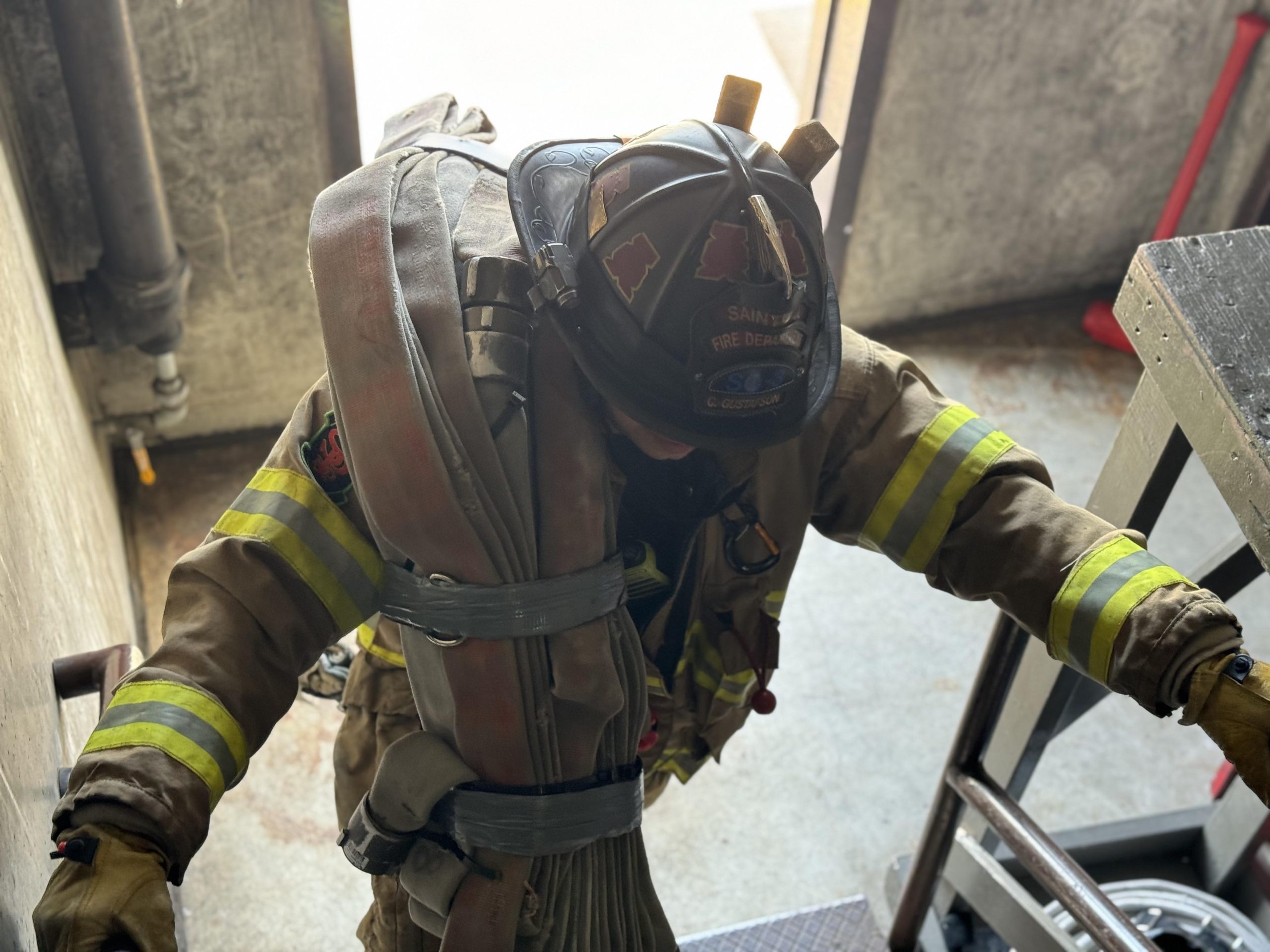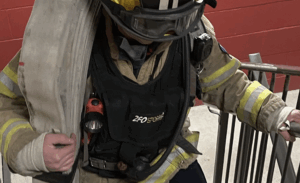Training Strategies for Excelling in the Timed Firefighter Physical Ability Test – bridges the divide between general fitness and the unique demands of the test.
Why is it important?
- Training tailored to the components of the timed physical ability test ensures you’re well-prepared for the specific challenges posed by tasks like the stair climb, hose drag, rescue dummy drag, equipment carry, and the Keiser sled forcible entry prop.
- Specific training sharpens the skills and strengths demanded by each component, optimizing your performance, and boosting your confidence, ultimately maximizing your potential to excel on test day.
Read on and prepare yourself for the physically intense and unpredictable challenges firefighter candidates encounter during the test.
Table of Contents
Setting Your Fitness Goals
Identify Test Components:
- Understand the timed physical ability test components.
- List required skills and skill levels.
Tailor Your Program:
- Customize your fitness routine for the timed physical ability test.
- Consider the mix of sprints and endurance.
Plan for Endurance:
- Train for explosive energy and endurance.
- Prepare for continuous activity.
Prioritize Health:
- Consult a doctor before starting.
- Begin with lighter weights and progress safely.
Simulate What You're Up Against
Strategies to excel in the timed firefighter physical ability test event-specific conditioning include:
- Stair Climb: Simulate climbing six flights of stairs with a weighted vest and SCBA while carrying a hose bundle, emulating the urgency of navigating a fire scene.
- Hose Hoist: Simulate hoisting a heavy hose line to the sixth floor of an elevated platform, assessing upper body and core strength.
- Hose Drag: Simulate dragging a charged hose line 100’ along a designated course to evaluate upper body strength and endurance.
- Equipment Carry: Simulate carrying various firefighting tools and equipment (typically two saws or one box fan) 75’, testing your ability to handle weight and maintain balance.
- Forcible Entry Prop: Simulate using a sledgehammer to advance a weighted sled prop (Keiser Sled) to imitate forcible entry, gauging upper body strength and coordination.
- Rescue Dummy Drag: Simulate maneuvering a weighted rescue dummy to safety by lifting and dragging a 165-pound dummy for 70’, testing candidates’ strength, endurance, and ability to perform under stress.
Each component hones specific skills vital for firefighting scenarios, preparing you to excel in the firefighter-timed physical ability test. We will cover them in greater detail in the following pages.
Assembling your equipment
Determining and incorporating equipment and tools into your training for the PAT will ultimately depend on your creativity, imagination, and budget. Below are examples of equipment you may need for workouts.
Tools, Equipment, and Why You Need Them
Calendar: Schedule workouts, study sessions, and critical dates with a calendar.
Notebook or notepad: Track your progress, record your strength and endurance goals, and track your progress with a notebook.
Stopwatch: Time your practice test runs. Purchase a firefighter watch or Fitbit device can also be used for this purpose.
Footwear: Most test administrators allow you to wear your footwear. Consider purchasing a good pair of athletic shoes and wearing them. Pick shoes designed for the rigors of the physical performance test, such as cross-training shoes (which are often more supportive than running shoes).
Firefighter gloves: Most test administrators allow you to wear your firefighter gloves. Consider purchasing a good pair of firefighter gloves and get used to wearing them.
Weighted vest: Most PATs require wearing a weighted vest during the test. A weighted vest is a good investment if you can afford it since it will simulate the extra weight you’ll carry during the Firefighter Physical Ability Test.
Exercise equipment: Incorporating kettlebells into your training routine effectively emulates the weight and demands of the equipment carry component in the Firefighter Physical Ability Test.
Build custom props: A cost-effective way to build training props is to use 25-lb. and 40-lb. salt bags to replicate many test components. Purchase a 10-lb. rubber sledgehammer and a 6”x6”x8’ timbers to make a forcible entry prop.
Specialized Equipment: Use a fitness weight bag to simulate the hose bundle, equipment carry or to make a rescue dummy drag bag to specialize your training.
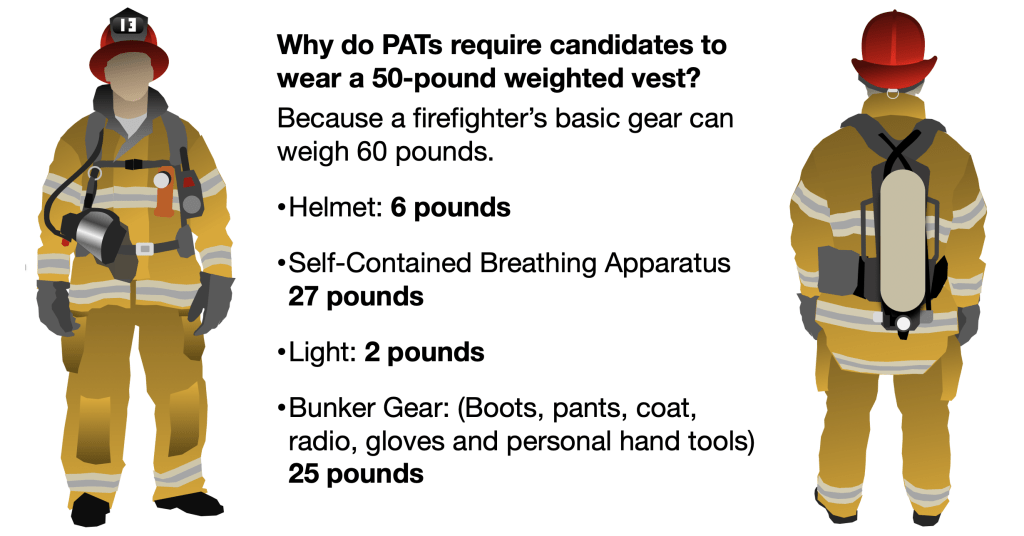
Setting up the Timed-Physical Ability Test course
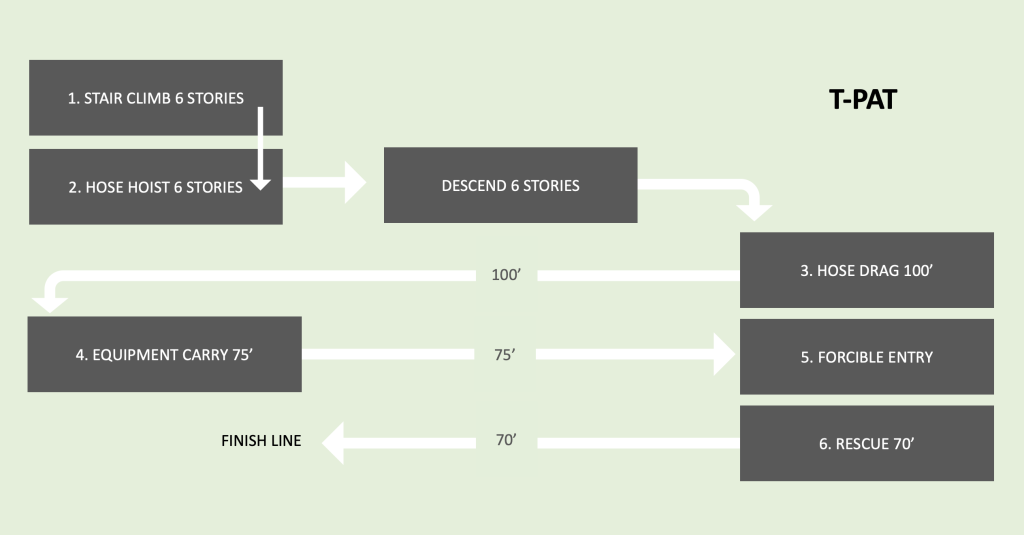
#1 Mastering the Stair Climb
The stair climb is a quintessential component of the timed firefighter physical ability test, an actual test of endurance, strength, and mental fortitude. As you embark on your journey to becoming a firefighter, conquering this challenge is a pivotal step. This guide delves into the stair climb, its significance, and the most effective training strategies to ensure you’re ready to ascend confidently on test day.
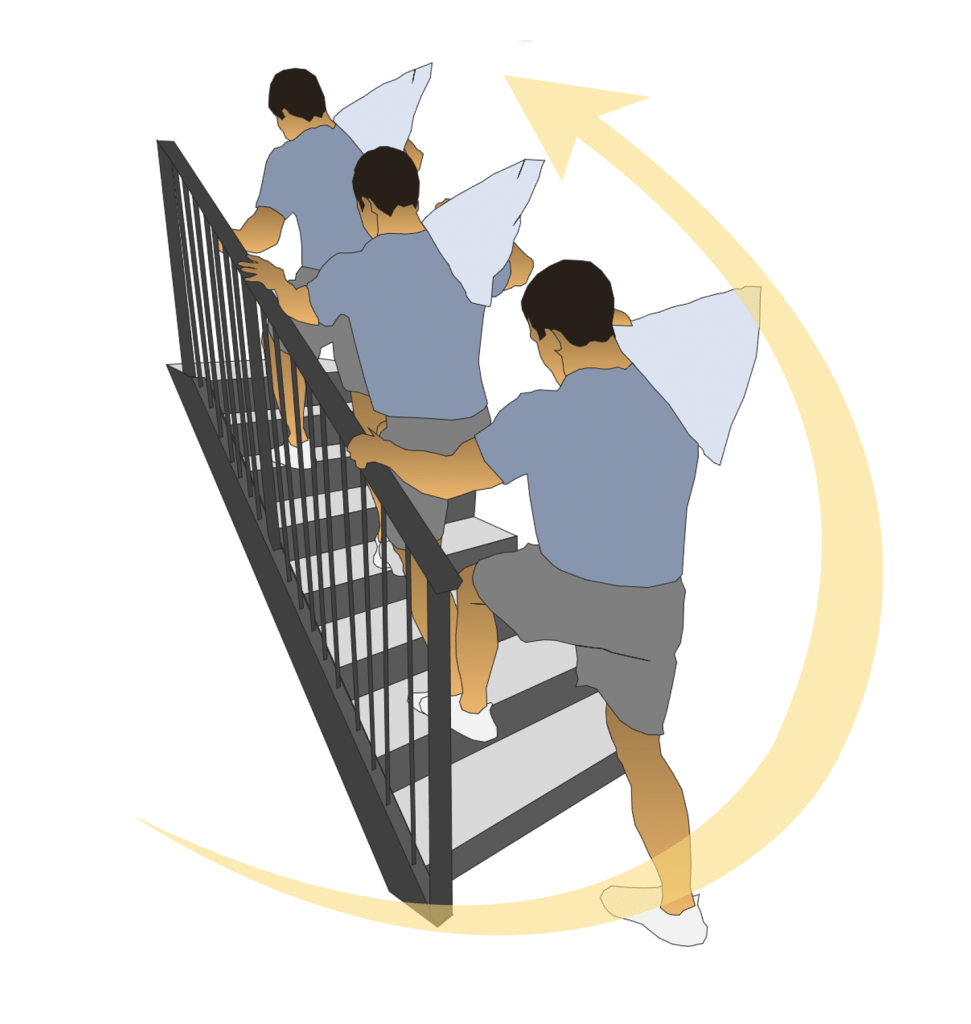
The stair climb is critical to the timed firefighter’s fitness test, mimicking real-life challenges. This guide explains its significance and offers practical training tips:
Significance: The stair climb emulates real firefighting situations, assessing your endurance and mental fortitude. It is the first phase of the test. Excelling here sets the tone and builds the confidence needed to succeed in the remainder of the exam.
1. Training Techniques and Tips:
- Find a matching staircase.
- Start with climbing and descending.
- Progress with a weighted vest and salt bag.
2. Other Training Strategies:
- Cardiovascular conditioning.
- Specific stair training.
- Interval workouts.
- Weighted vest and sand/salt bag.
- Leg strength exercises.
- Focus on efficient technique.
- Mental resilience techniques.
- Prioritize recovery.
3. Approaching Test Day:
- Simulated runs to track progress.
- Proper nutrition and hydration.
- Rest before the test.
Test Day Tips:
- Distribute hose bundle weight on the SCBA.
- Use the handrail for balance.
- Skip steps on the way up.
- Practice hitting the target on the sixth floor with the bundle before descending.
- Follow the rules for descending.
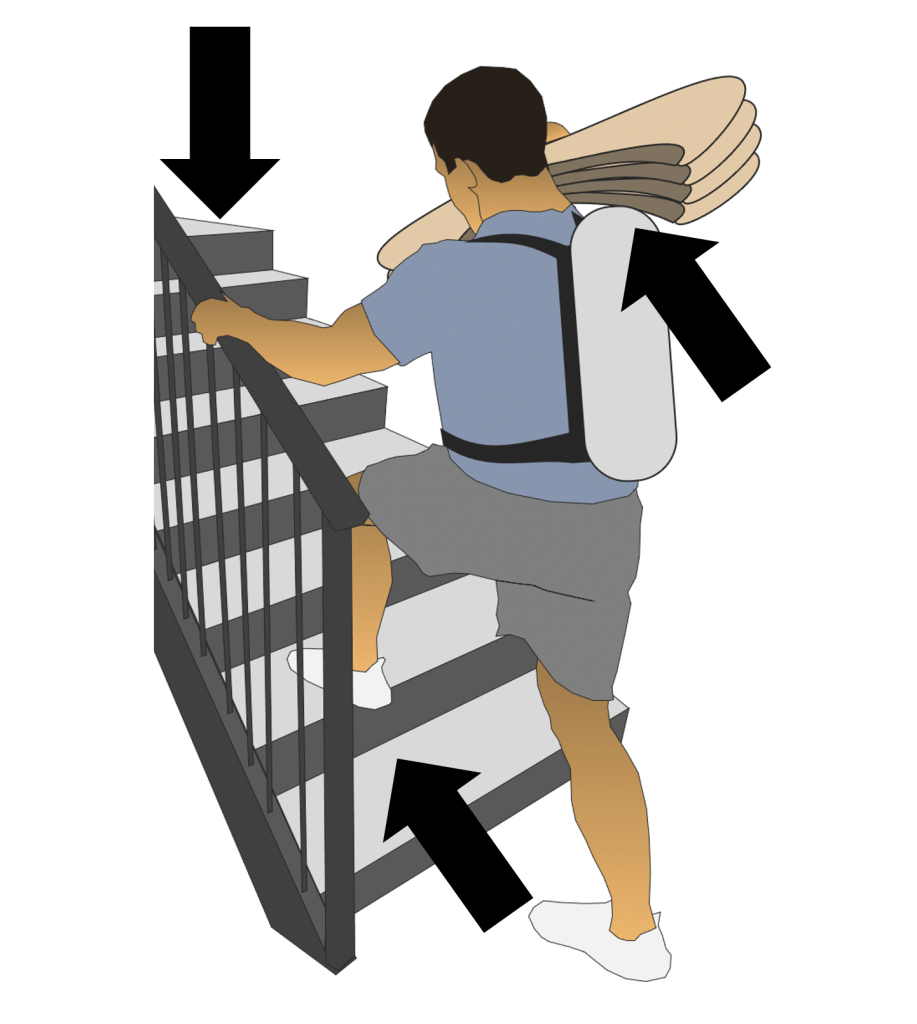
It’s critical your training prepares you for this first phase. It could be over if you’re not.
#2 Mastering the Hose Hoist
The hose hoist component of the Timed Firefighter Physical Ability Test is a testament to your upper body strength, coordination, and determination. This guide is your compass, leading you through a comprehensive training approach specifically tailored to conquer the hose hoist challenge and emerge as a prepared and confident firefighter candidate.
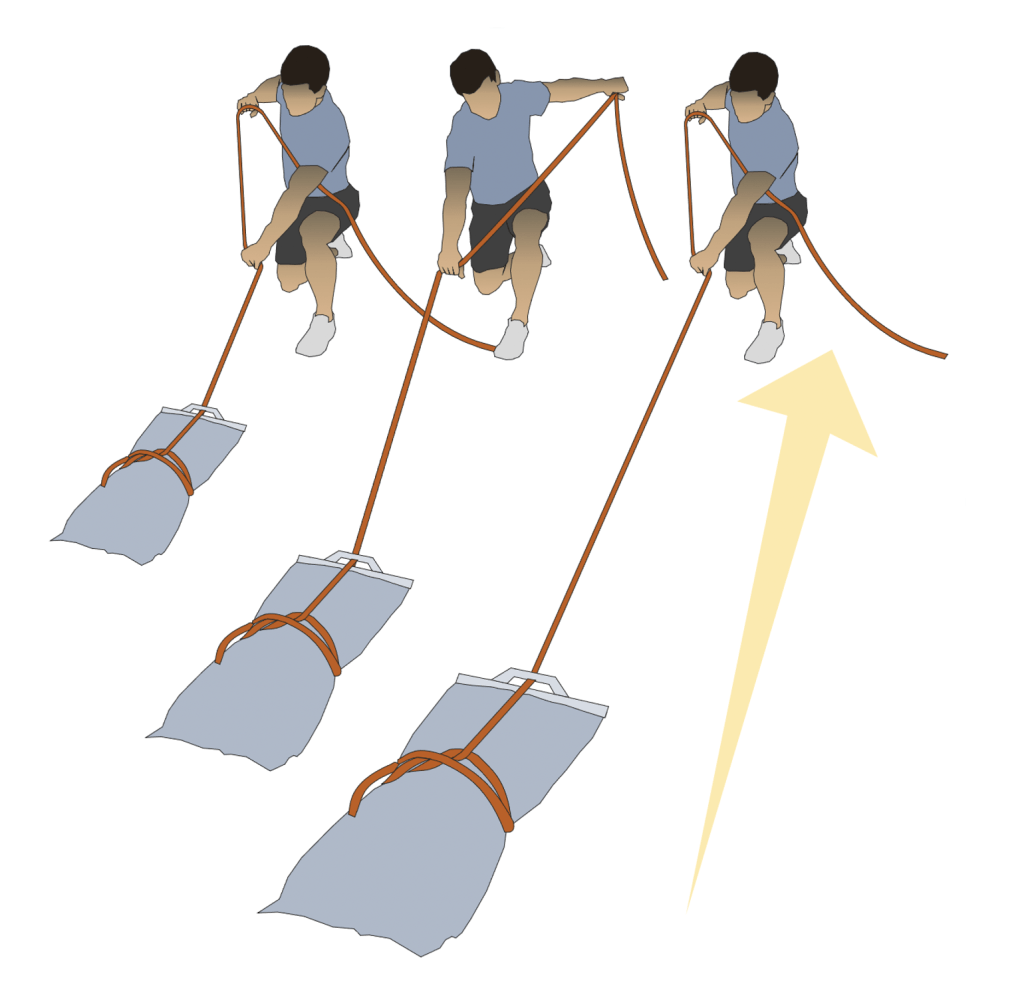
The hose hoist is a less frequently seen challenge during the timed firefighter physical ability test. However, this guide explains its significance and offers practical training tips:
Significance: The hose hoist simulates hoisting a heavy hose line for firefighting. It evaluates physical prowess, technique, and mental resilience.
1. Training Techniques and Tips:
- Attach a 45-pound salt bag to a rope.
- Pull it hand-over-hand until retrieved.
- Lower and repeat until fatigued.
2. Additional Training:
- Build upper body strength with exercises like pull-ups.
- Strengthen grip with specialized exercises.
- Use weighted tools to mimic hose resistance.
- Incorporate high-intensity interval training.
- Refine technique with lighter objects.
- Familiarize with test equipment.
3. Test Day Preparation:
- Conduct mock hose hoist runs.
- Maintain proper nutrition and hydration.
- Rest before the test.
Test Day Tips:
- Use an over-hand grip for shoulder and back support.
- Pull the rope up and in to prevent interference.
- Place the hose roll on the target before descending.

The hose hoist symbolizes upper body strength. With focused technique and training, you’ll master this skill.
#3 Mastering the Hose Drag
The hose drag component of the Timed Firefighter Physical Ability Test is a critical assessment of your upper body strength, coordination, and determination. This guide is your roadmap, leading you through a targeted training approach designed to conquer the hose drag challenge and position you as a confident and capable firefighter candidate.
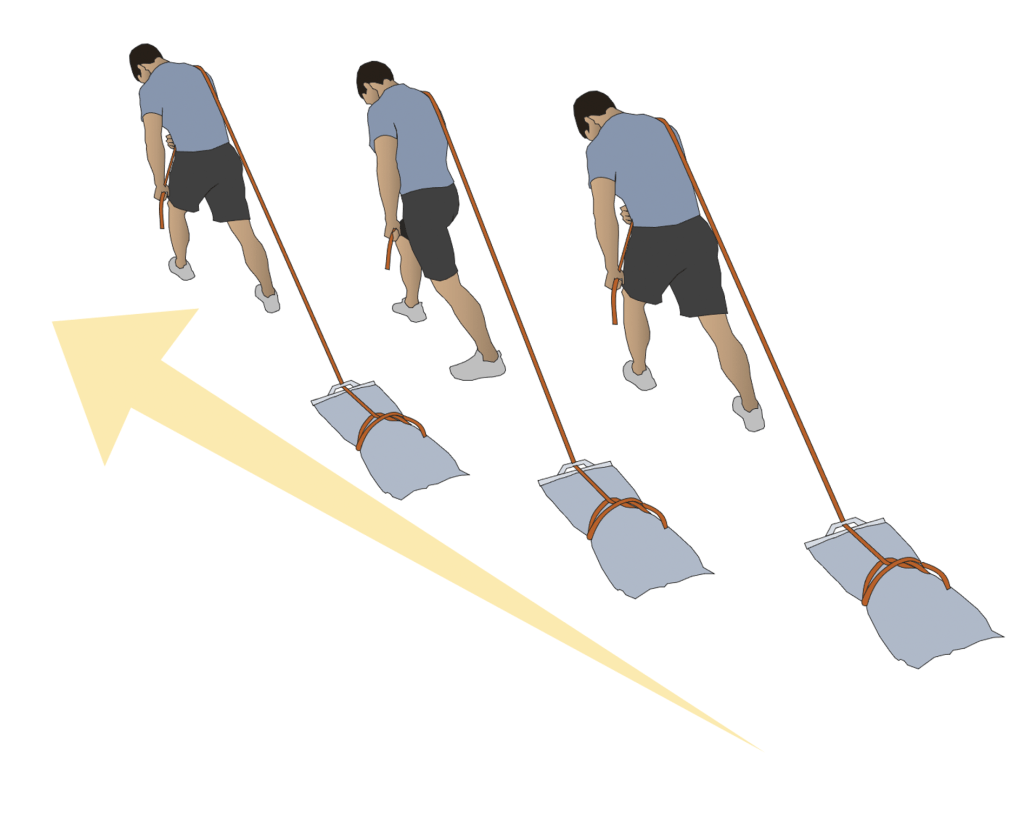
Significance: It simulates dragging a charged hose line to establish a water supply. It evaluates your ability to handle the hose’s weight with precision and control, testing physical prowess and mental focus under pressure.
1. Training Techniques and Tips:
- Attach a weighted salt bag to a rope and drag it.
- Loop the rope over your shoulder with a two-handed, thumbs-up grip at waist level.
- Increase intensity as you progress.
2. Other Training Strategies:
- Strengthen your upper body with exercises like rows, pull-ups, and push-ups.
- Focus on grip training.
- Practice hose handling and full-body conditioning.
- Use interval training for bursts of effort.
- Maintain proper technique and simulate real-world conditions.
3. Approaching Test Day:
- Perform mock hose drags.
- Pay attention to nutrition and hydration.
- Rest before the test.
Test Day Tips and Tricks:
- Position your body correctly for lifting and dragging.
- Ensure proper hose length and kink to lock it at your shoulder.
- Maintain a straight-arm grip.
- Lean forward to advance the hose.
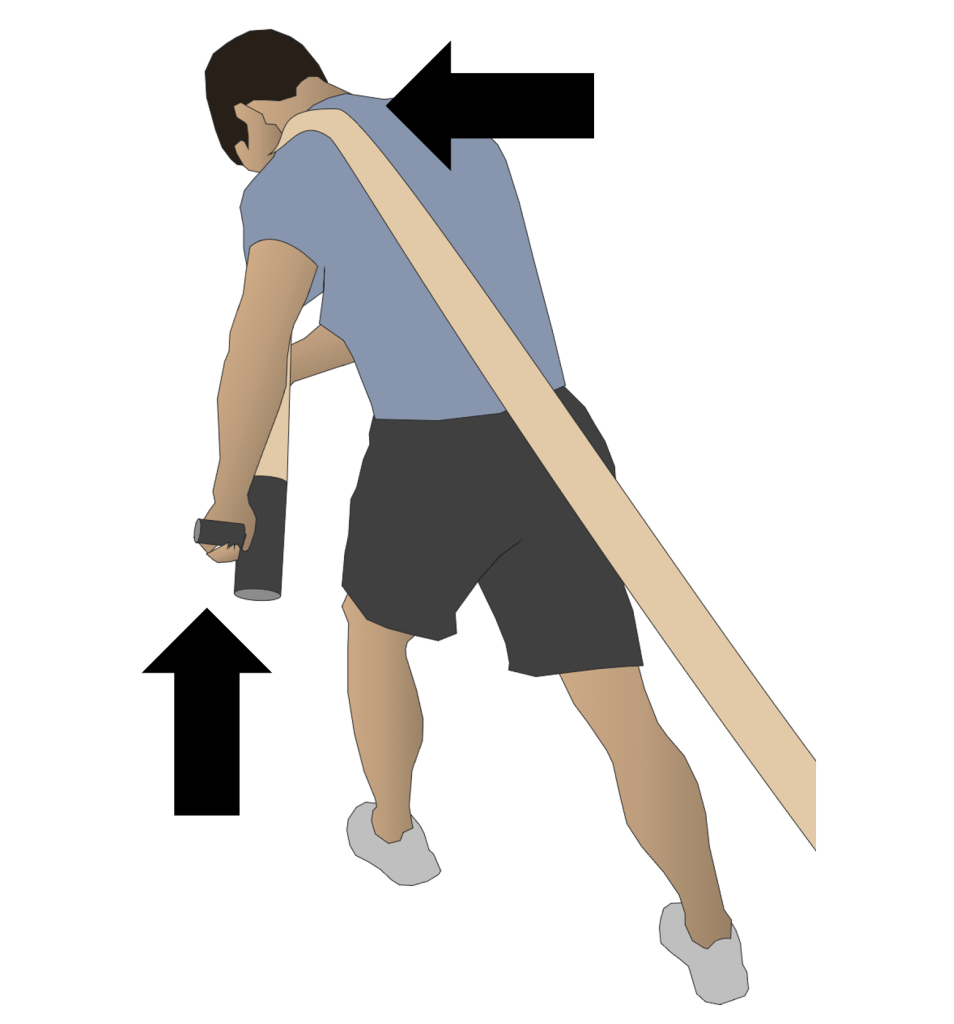
Practicing the hose drag is a crucial step toward cutting time on your test.
#4 Mastering the Equipment Carry
The equipment carry, a Timed Firefighter Physical Ability Test component staple, is a testament to your strength, balance, and determination. This guide serves as your compass, guiding you through a strategic training approach tailored to conquer the equipment carry challenge and elevate your readiness as a firefighter candidate.
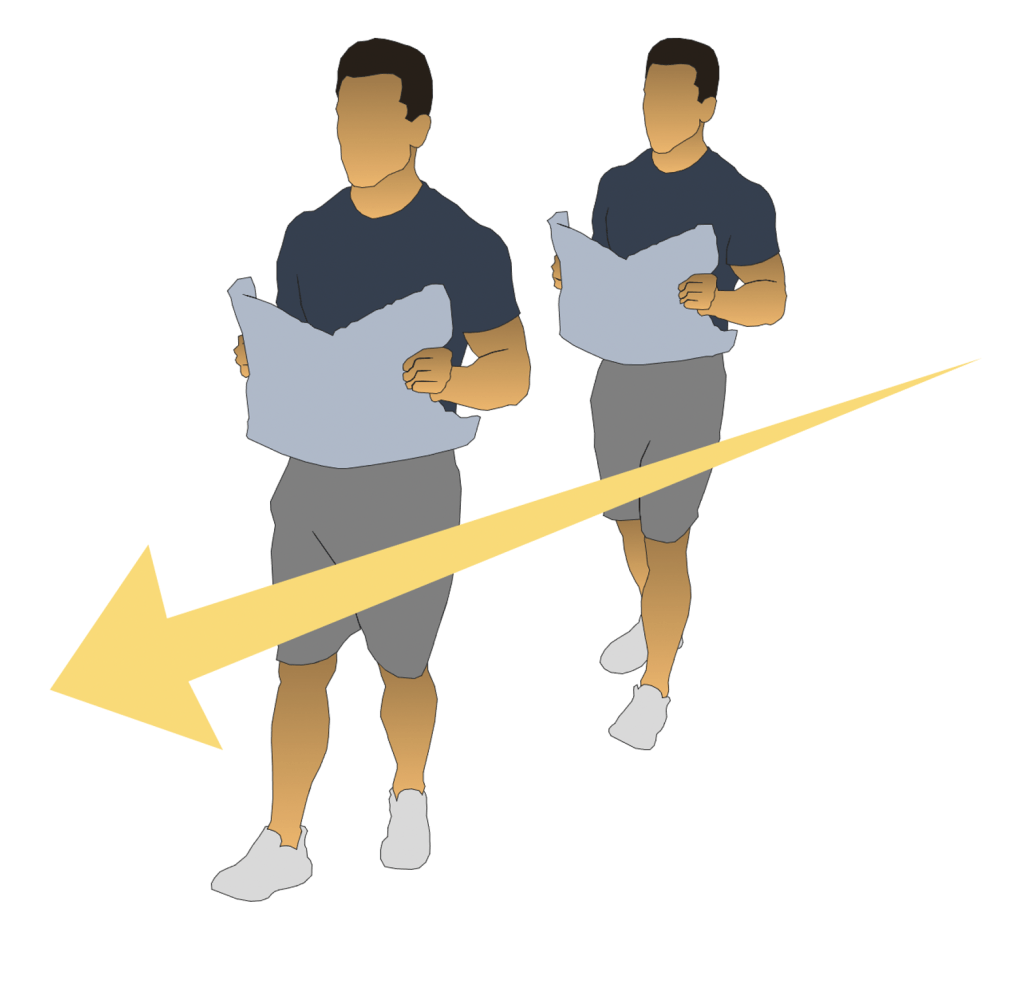
Significance: It mirrors carrying heavy tools and gear to the scene. Evaluates your ability to handle weight with stability, control, technique, and mental fortitude under pressure.
1. Training Techniques and Tips:
- For the box fan carry, lift a 45-pound salt bag or kettlebell and hold it against your chest.
- For two gas-powered tools, practice with two 25-pound salt bags or kettlebells.
- Increase intensity as you progress.
2. Other Training Strategies:
- Prioritize full-body strength training, including deadlifts, squats, and lunges.
- Strengthen your grip with farmer’s walks, rope climbs, and plate pinches.
- Use weighted carries with kettlebells, dumbbells, or sandbags.
- Enhance balance and stability with single-leg squats and stability ball exercises.
- Strengthen your core with planks, Russian twists, and hanging leg raises.
- Incorporate interval training for bursts of effort.
- Focus on proper lifting technique and practice runs.
3. Approaching Test Day:
- Conduct mock equipment carry runs.
- Maintain proper nutrition and hydration.
- Ensure rest a day or two before the test.
Test Day Tips and Tricks:
- For the box fan carry, center yourself in front of it and lift it tight to your chest.
- Keep the cutting side facing forward or backward for chainsaw carry to prevent tilting.
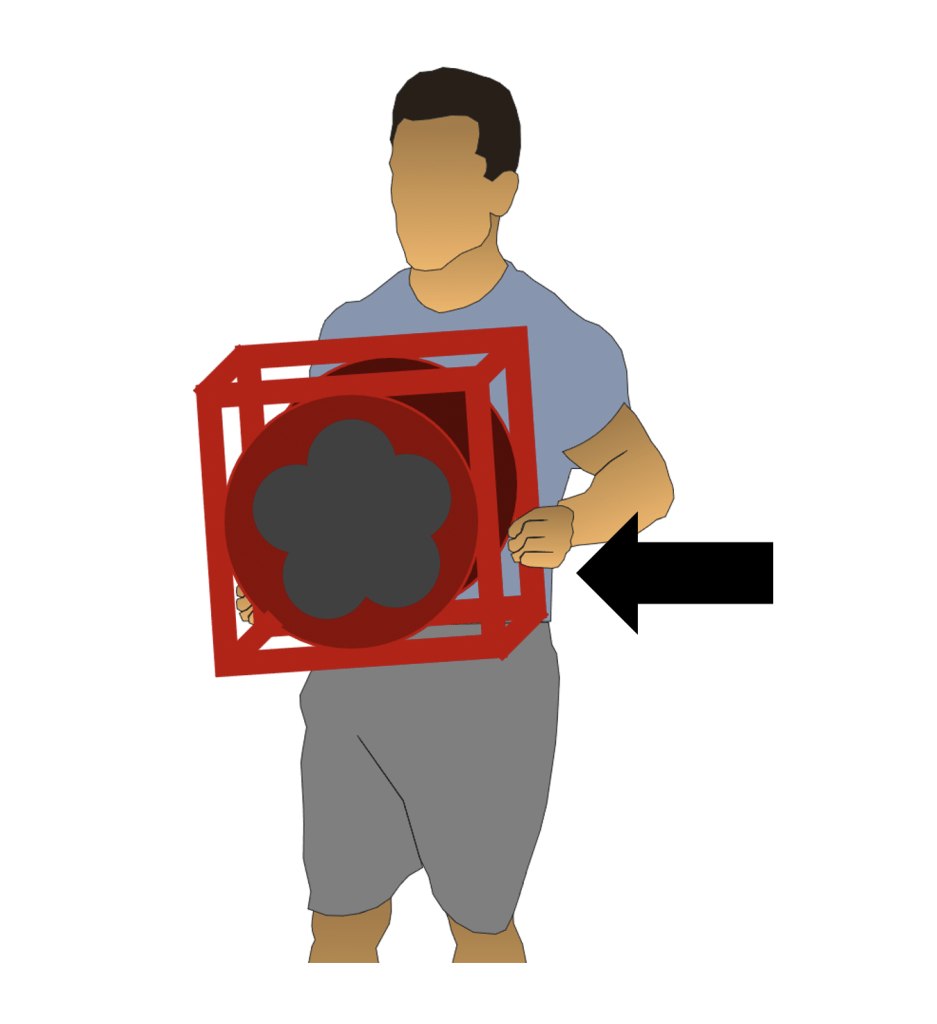
You’ll confidently conquer the equipment carry with dedicated training and technique refinement.
#5 Mastering the Keiser Forcible Entry Prop
Preparing for the forceful entry prop component of the Timed Firefighter Physical Ability Test, mainly using the Keiser sled, requires strategic training methods to ensure you’re primed for success. This guide is your roadmap, offering practical strategies to conquer the forceful entry challenge without direct access to a Keiser sled for practice.
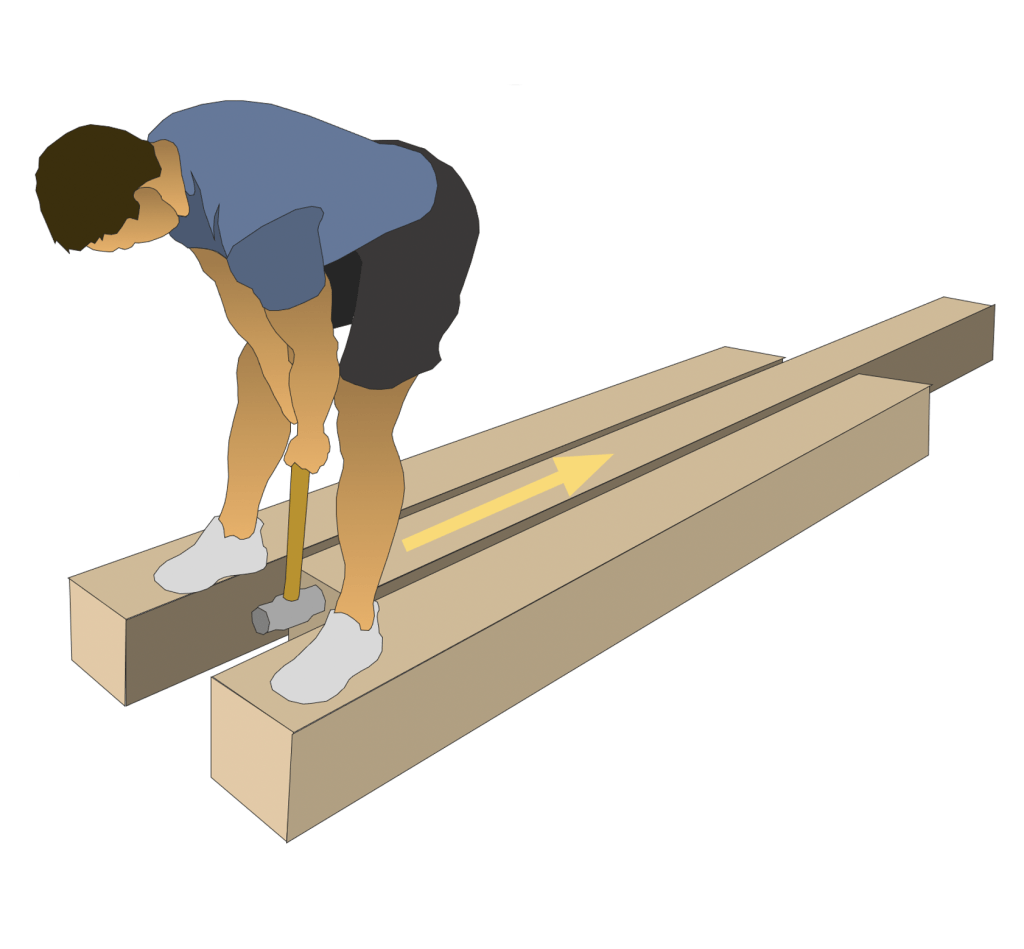
Significance: It simulates breaking through doors or barriers during emergencies. Measures upper body strength, coordination, and tool manipulation skills. Emphasizes technique, determination, and adaptability.
1. Training Techniques and Tips:
- Use three 6” x 6” x 8’ timbers to replicate the Keiser sled prop.
- Practice hitting the center timber with a 10-pound sledgehammer and follow its movement.
- Increase intensity by adding salt bags to the timbers.
2. Other Training Strategies:
- Strengthen upper body muscles with push-ups, bench presses, and overhead lifts.
- Enhance core stability with planks, Russian twists, and medicine ball
- Include explosive movements like plyometric push-ups and box jumps.
- Develop grip strength with towel hangs, farmer’s walks, and plate pinches.
- Simulate striking motions with similar tools to the Keiser sled.
- Use a ten lb. sledgehammer for striking practice focusing on core and upper body power.
- Visualize successful prop operation for mental readiness.
- Engage in full-body conditioning for strength, endurance, and agility.
3. Approaching Test Day:
- Conduct mock drills to assess progress and technique.
- Maintain proper nutrition and hydration for sustained energy.
- Rest a day or two before the test for muscle recovery.
Test Day Tips and Tricks:
- Position your feet correctly and grip the sledgehammer properly.
- Swing in line with your body and the sled.
- Create a fluid, coordinated motion using legs, back, and arms.
- Avoid large over-the-head swings, instead use faster medium hits for efficiency.
- Keep up with the sled’s strike plate with your feet and legs in sink.
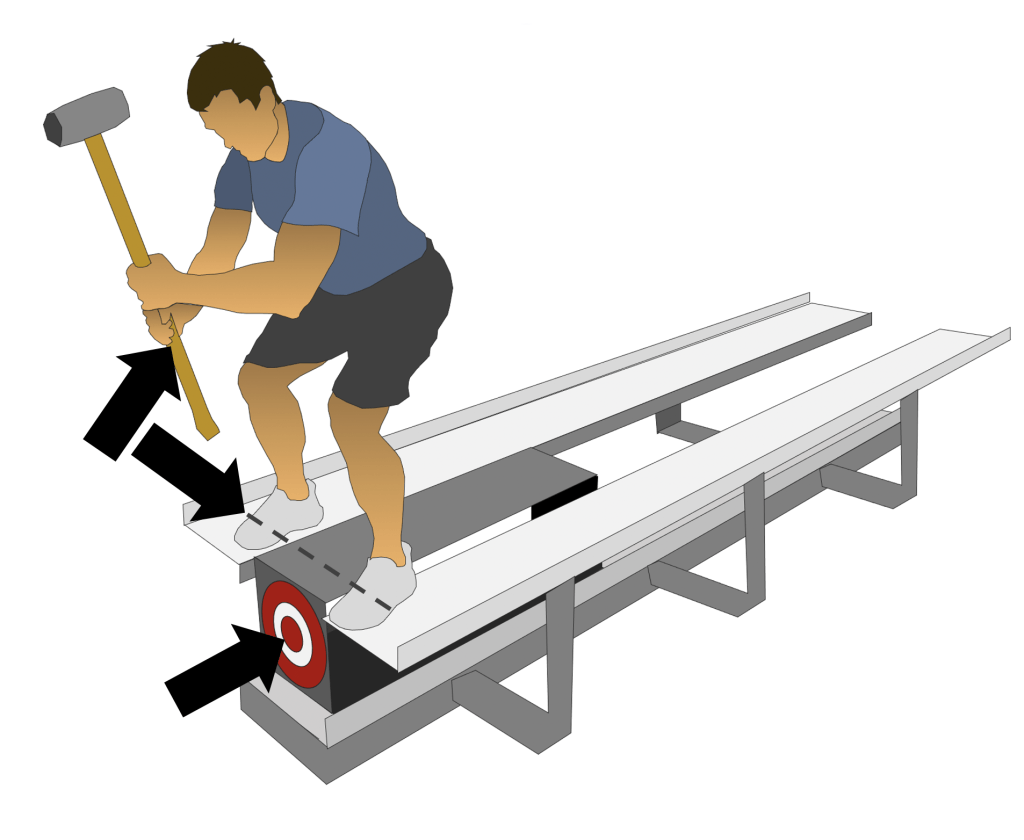
Dedicated practice sessions and technique refinement are critical. You’ll confidently face this event even without a Keiser sled to practice with.
#6 Mastering the Rescue Dummy Drag
The dummy drag is the most challenging event to accomplish. Many candidates need to improve at this component of the test. Preparing for the rescue dummy drag requires a dedicated training approach encompassing strength, endurance, and mental fortitude. This guide serves as your compass, leading you through a targeted preparation strategy to conquer the rescue dummy drag challenge and emerge as a capable and confident firefighter candidate.
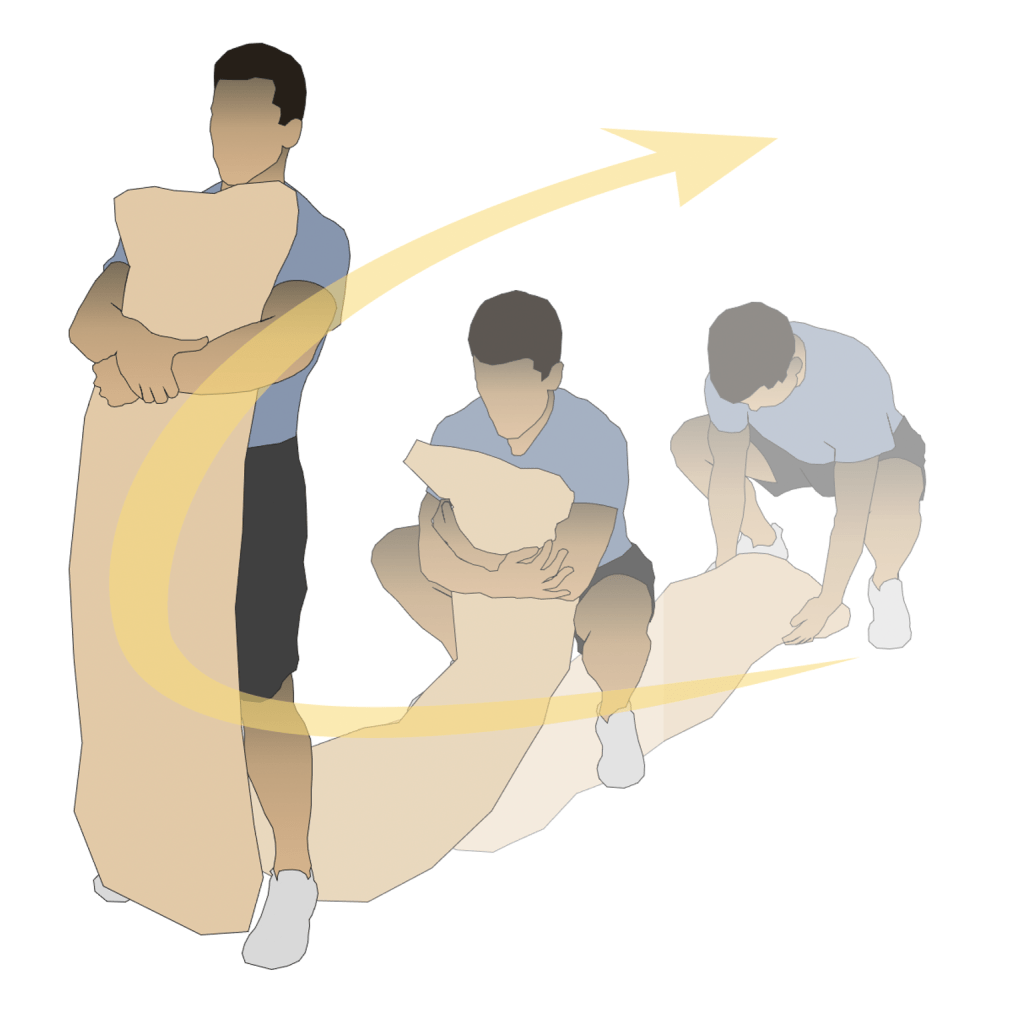
Significance of the Rescue Dummy Drag: It simulates vital firefighter tasks—rescuing and evacuating victims from hazardous environments. Evaluates upper body strength, lower body power, and resilience. Emphasizes technique, coordination, and composure under pressure.
1. Training Techniques and Tips:
- Create a dummy by stacking four 40-pound salt bags (total 160 pounds) on a tarp, resembling the dummy drag mannequin.
- Securely fold and roll the tarp with duct tape.
- If you can afford it, check out this pre-made dummy drag bag designed to help candidates train for this aspect of the test.
- Practice lifting it straight up, resting the weight on your chest, and walking backward until fatigued.
- Gradually increase the weight to match the test day load.
2. Other Training Strategies:
- Prioritize full-body strength with exercises like deadlifts, squats, and rows.
- Develop upper body power with pull-ups, rows, and bench presses.
- Strengthen your grip with farmer’s walks, towel hangs, and grip trainers.
- Enhance leg power with plyometric exercises like box jumps and kettlebell swings.
- Improve endurance through cardiovascular activities.
- If possible, simulate the drag with sled pulls.
- Integrate high-intensity interval training (HIIT).
- Focus on proper lifting and dragging technique, engaging legs and core.
- Mentally rehearse the task through visualization.
3. Approaching Test Day:
- Conduct mock rescue dummy drag runs.
- Maintain proper nutrition and hydration.
- Ensure a day or two of rest before the test for muscle recover
Test Day Tips and Tricks:
- Stand behind the weighted dummy and sit it in a seated position.
- Squat behind it, hug, or lock arms around it.
- Stand up, arch your back to distribute weight to your chest, and walk backward with energy.
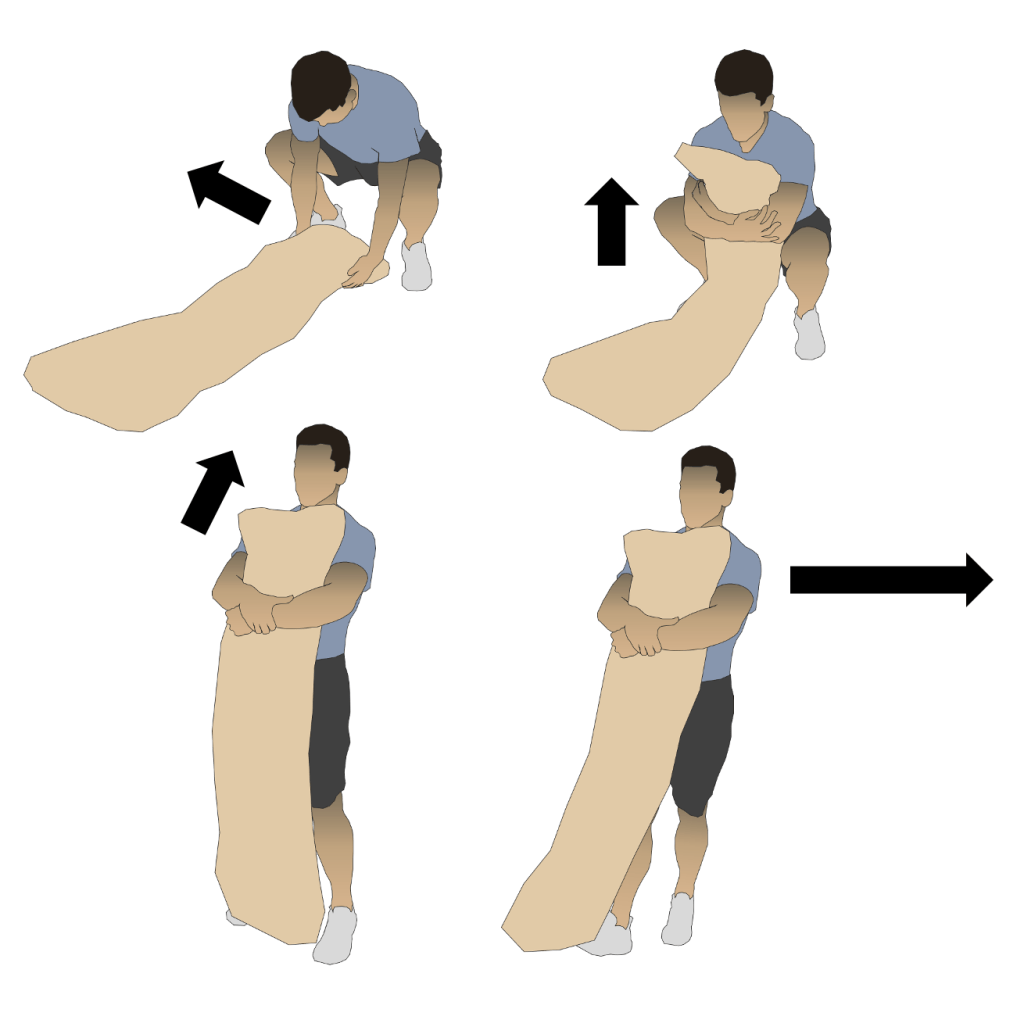
With dedicated training, determination, and technique refinement, you’ll master this crucial skill.
Learn How You Can Become A Firefighter
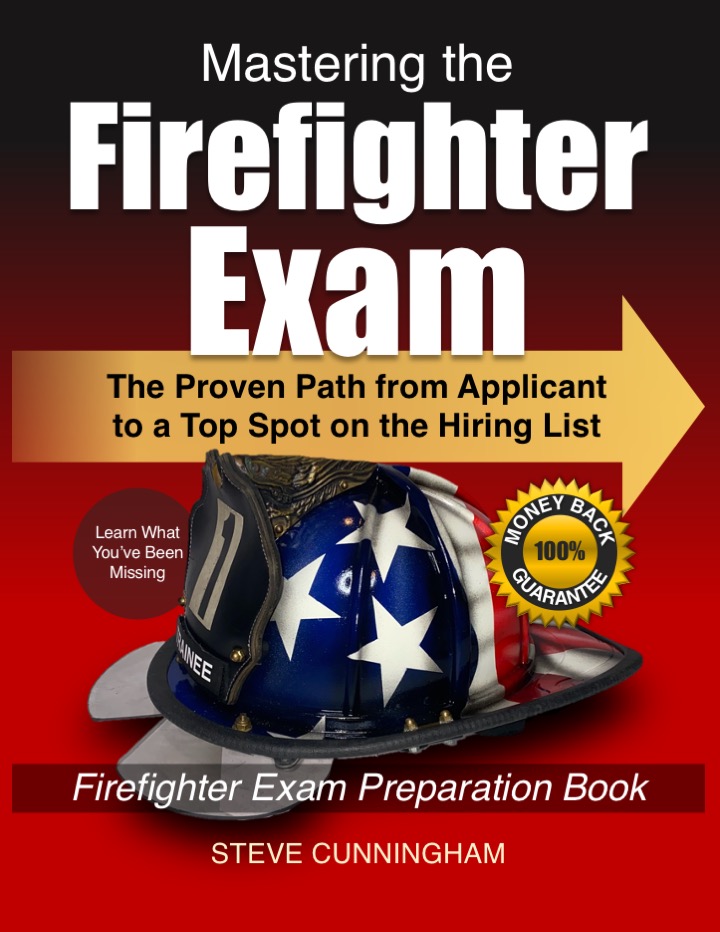
Mastering the Firefighter Exam is a complete guide on how to pass the firefighter exam with a top score. It simplifies the complicated hiring practices of big city fire departments and reveals insider information most candidates don’t know about.
If You Would Like To Know How To Get A Head Of Your Competition, This Book Is For You.

